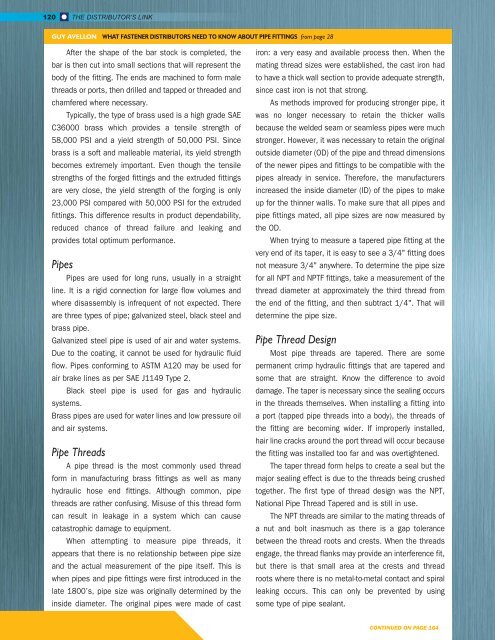WINTER 2016
Distributor's Link Magazine Winter Issue 2016 / Vol 39 No1
Distributor's Link Magazine Winter Issue 2016 / Vol 39 No1
Create successful ePaper yourself
Turn your PDF publications into a flip-book with our unique Google optimized e-Paper software.
120 THE DISTRIBUTOR’S LINK<br />
GUY AVELLON WHAT FASTENER DISTRIBUTORS NEED TO KNOW ABOUT PIPE FITTINGS from page 28<br />
After the shape of the bar stock is completed, the<br />
bar is then cut into small sections that will represent the<br />
body of the fitting. The ends are machined to form male<br />
threads or ports, then drilled and tapped or threaded and<br />
chamfered where necessary.<br />
Typically, the type of brass used is a high grade SAE<br />
C36000 brass which provides a tensile strength of<br />
58,000 PSI and a yield strength of 50,000 PSI. Since<br />
brass is a soft and malleable material, its yield strength<br />
becomes extremely important. Even though the tensile<br />
strengths of the forged fittings and the extruded fittings<br />
are very close, the yield strength of the forging is only<br />
23,000 PSI compared with 50,000 PSI for the extruded<br />
fittings. This difference results in product dependability,<br />
reduced chance of thread failure and leaking and<br />
provides total optimum performance.<br />
Pipes<br />
Pipes are used for long runs, usually in a straight<br />
line. It is a rigid connection for large flow volumes and<br />
where disassembly is infrequent of not expected. There<br />
are three types of pipe; galvanized steel, black steel and<br />
brass pipe.<br />
Galvanized steel pipe is used of air and water systems.<br />
Due to the coating, it cannot be used for hydraulic fluid<br />
flow. Pipes conforming to ASTM A120 may be used for<br />
air brake lines as per SAE J1149 Type 2.<br />
Black steel pipe is used for gas and hydraulic<br />
systems.<br />
Brass pipes are used for water lines and low pressure oil<br />
and air systems.<br />
Pipe Threads<br />
A pipe thread is the most commonly used thread<br />
form in manufacturing brass fittings as well as many<br />
hydraulic hose end fittings. Although common, pipe<br />
threads are rather confusing. Misuse of this thread form<br />
can result in leakage in a system which can cause<br />
catastrophic damage to equipment.<br />
When attempting to measure pipe threads, it<br />
appears that there is no relationship between pipe size<br />
and the actual measurement of the pipe itself. This is<br />
when pipes and pipe fittings were first introduced in the<br />
late 1800’s, pipe size was originally determined by the<br />
inside diameter. The original pipes were made of cast<br />
iron: a very easy and available process then. When the<br />
mating thread sizes were established, the cast iron had<br />
to have a thick wall section to provide adequate strength,<br />
since cast iron is not that strong.<br />
As methods improved for producing stronger pipe, it<br />
was no longer necessary to retain the thicker walls<br />
because the welded seam or seamless pipes were much<br />
stronger. However, it was necessary to retain the original<br />
outside diameter (OD) of the pipe and thread dimensions<br />
of the newer pipes and fittings to be compatible with the<br />
pipes already in service. Therefore, the manufacturers<br />
increased the inside diameter (ID) of the pipes to make<br />
up for the thinner walls. To make sure that all pipes and<br />
pipe fittings mated, all pipe sizes are now measured by<br />
the OD.<br />
When trying to measure a tapered pipe fitting at the<br />
very end of its taper, it is easy to see a 3/4" fitting does<br />
not measure 3/4" anywhere. To determine the pipe size<br />
for all NPT and NPTF fittings, take a measurement of the<br />
thread diameter at approximately the third thread from<br />
the end of the fitting, and then subtract 1/4". That will<br />
determine the pipe size.<br />
Pipe Thread Design<br />
Most pipe threads are tapered. There are some<br />
permanent crimp hydraulic fittings that are tapered and<br />
some that are straight. Know the difference to avoid<br />
damage. The taper is necessary since the sealing occurs<br />
in the threads themselves. When installing a fitting into<br />
a port (tapped pipe threads into a body), the threads of<br />
the fitting are becoming wider. If improperly installed,<br />
hair line cracks around the port thread will occur because<br />
the fitting was installed too far and was overtightened.<br />
The taper thread form helps to create a seal but the<br />
major sealing effect is due to the threads being crushed<br />
together. The first type of thread design was the NPT,<br />
National Pipe Thread Tapered and is still in use.<br />
The NPT threads are similar to the mating threads of<br />
a nut and bolt inasmuch as there is a gap tolerance<br />
between the thread roots and crests. When the threads<br />
engage, the thread flanks may provide an interference fit,<br />
but there is that small area at the crests and thread<br />
roots where there is no metal-to-metal contact and spiral<br />
leaking occurs. This can only be prevented by using<br />
some type of pipe sealant.<br />
CONTINUED ON PAGE 164

















